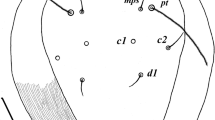Abstract
A new quill mite species having dimorphic females Stibarokris annae n. sp. (Acariformes: Syringophilidae) is described from the maguari stork Ciconia maguari (Gmelin) (Ciconiiformes: Ciconiidae) from Uruguay. “S-form” females of S. annae differ from S. phoeniconaias Skoracki & OConnor, 2010 by the hysteronotal shield not reaching setal bases d1 (vs hysteronotal shield bearing setal bases d2 and d1 in S. phoeniconaias), the length ratio of setae ag1:ag2:ag3 1:1–1.4:2–2.4 (vs 1:1:1.2–1.3), the genital setae g1 2–2.5 times as long as g2 (vs g1 1.4–1.8× as long as g2), the fan-like setae of legs III–IV with 15–17 tines (vs with 6–8 tines) and the length of setae f2 (230–255 vs 295–370 µm), h1 (25–30 vs 45–55 µm), ag1 (125–165 vs 245–285 µm) and ag2 (145–180 vs 245–270 µm). “C-form” females of S. annae are distinguishable from S. phoeniconaias (“C-form”) by the longitudinal branch of the peritremes with 14–16 chambers (vs 12–13 chambers in S. phoeniconaias), the propodonotal shield weakly sclerotised and punctate along its lateral borders (vs well sclerotised and apunctate), the hysteronotal shield represented by an oval area covered by delicate striations (vs distinct hysteronotal shield), genital setae g1 1.5–1.8 times as long as g2 (vs g1 and g2 subequal in length), the fan-like setae p’ and p” with 10 tines (vs with 5 tines) and the length of setae ve (120–130 vs 185–195 µm), si (120–130 vs 220 µm), se (180–200 vs 245–295 µm), c1 (180–195 vs 270–285 µm), d2 (180–205 vs 265–270 µm), d1 (195–205 vs 255–285 µm) and e2 (195–215 vs 285–320 µm).



Similar content being viewed by others
References
Bochkov, A. V., & Mironov, S. V. (1999). New quill mite species of the family Syringophilidae (Acari: Cheyletoidea) from the European part of Russia. Acarina, 7, 35–45.
Bochkov, A. V., OConnor, B. M., & Wauthy, G. (2008). Phylogenetic position of the family Myobiidae within the Prostigmata (Acari: Acariformes). Zoologischer Anzeiger, 247, 15–45.
Clements, J. F., Schulenberg, T. S., Iliff, M. J., Roberson, D., Fredericks, T. A., Sullivan, B. L., & Wood, C. L. (2014). The eBird/Clements checklist of birds of the world: Version 6.9. Downloaded from http://www.birds.cornell.edu/clementschecklist/download/ (accessed 1 August 2014).
Del-Hoyo, J., Elliott, A., & Sargatal, J. (Eds) (1992). Handbook of the Birds of the World, Volume 1 (Ostrich to Ducks). Barcelona: Lynx Editions, 696 pp.
Glowska, E., & Skoracki, M. (2011). New species of quill mites (Acari, Cheyletoidea, Syringophilidae) and the first record of male for the genus Stibarokris. Zootaxa, 2817, 63–68.
Glowska, E., Dragun-Damian, A., Broda, L., Dabert, J., & Dabert, M. (2014). DNA barcodes reveal female dimorphism in syringophilid mites (Actinotrichida: Prostigmata: Cheyletoidea): Stibarokris phoeniconaias and Ciconichenophilus phoeniconaias are conspecific. Folia Parasitologica, 61, 272–276.
Grandjean, F. (1939). Les segments postlarvaires de l’hysterosoma chez les oribates (Acariens). Bulletin de la Société Zoologique de France, 64, 273–284.
Grandjean, F. (1944). Observations sur les acariens de la famille Stigmaeidae. Archives des Sciences Physiques et Naturelles, 26, 103–131.
Kethley, J. B. (1970). A revision of the family Syringophilidae (Prostigmata: Acarina). Contributions of the American Entomological Institute, 6, 1–76.
Kethley, J. B. (1990). Acarina: Prostigmata (Actinedida). In: Dindal, D. L. (Ed.) Soil Biology Guide. New York: Wiley & Sons, pp. 667–754.
Skoracki, M. (2011). Quill mites (Acari: Syringophilidae) of the Palaearctic region. Zootaxa, 2840, 1–414.
Skoracki, M., & OConnor, B. (2010). New taxa of quill mites (Acari: Cheyletoidea: Syringophilidae). Zootaxa, 2341, 1–32.
Acknowledgements
I am very grateful to the staff of the Department of Vertebrate Zoology, Division of Birds, National Museum of Natural History, Smithsonian Institution, Washington, DC, USA (USNM) for making the collection of feathers available for this study.
Conflict of interest
The author declares that she has no conflict of interest.
Compliance with ethical standards
All applicable institutional, national and international guidelines for the care and use of animals were followed.
Author information
Authors and Affiliations
Corresponding author
Rights and permissions
About this article
Cite this article
Glowska, E. Stibarokris annae n. sp. from Ciconia maguari (Gmelin) (Ciconiiformes: Ciconiidae), a new species of quill mites (Acariformes: Syringophilidae) exhibiting dimorphism of females. Syst Parasitol 92, 73–79 (2015). https://doi.org/10.1007/s11230-015-9580-1
Received:
Accepted:
Published:
Issue Date:
DOI: https://doi.org/10.1007/s11230-015-9580-1



